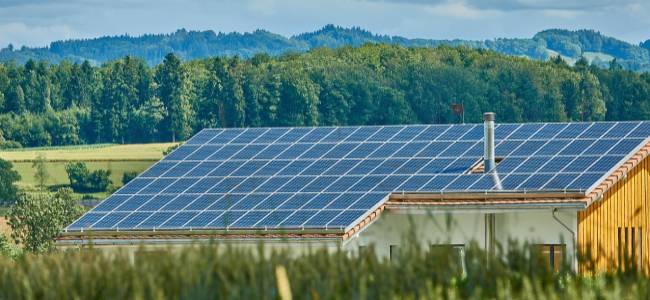How many solar panels do I need to power my home?

When people initially consider the idea of going solar, one of the first questions they have for us is pretty straightforward: how many solar panels do I need to power my home?
And while the answer changes based on a variety of factors – like electricity consumption, local climate, and the layout of your roof – the good news is there are plenty of resources (like this one) designed to help you get a reasonable estimate based on your energy usage habits.
In this article, we'll give you a quick formula to estimate what size solar system you need to power your home. It should give you a good ballpark figure to help decide whether solar is a worthy investment. If you decide to move forward with your project, you'll definitely want to refine these calculations with the help of your solar designer later down the line.
Quick Math: What Size Solar Kit Do I Need?
Here is the quick formula to estimate your system size:
Daily kWh usage ÷ Daily Production Hours ÷ Inefficiency Factor = Solar Kit Size
Let's look at each element step-by-step:
Daily kWh Usage
Your kWh (kilowatt-hour) usage is a measurement of how much electricity you use. This information will be printed on your monthly electric bill, and you should also be able to find it online, if your local utility has an account portal you can access.
Tally up your total kWh usage for the past year. You want to get a full year to account for swings in usage patterns based on the local climate.
Then, divide that number by 365 to get your daily energy usage. This will tell you how much electricity you use, and therefore, how much you have to produce each day.
Local Production Window
Your "production window" is the period of time each day where the sun is in a suitable position in the sky for your panels to be producing energy. This changes based on location, with most places in America averaging 3-5 hours of optimal production on a daily basis.
This information is tracked by the National Solar Radiation Database, who refers to this as the "solar irradiance" window. You can visit the link and enter your ZIP code to look up your solar irradiance levels on a map.

Alternatively, visit the PVWatts Calculator, enter your ZIP code, and click through to the results page. It will display the annual solar radiation for your location.
Write this number down.
Account for Inefficiencies
Solar panels suffer a small amount of degradation, or natural production loss over the lifecycle of the panels. A small amount of degradation is expected and covered under warranty.
A typical solar panel warranty guarantees panels will work at an 80-90% efficiency rating at the end of its 25-year lifespan. For example, a 400W panel working at an 85% rate would only output 340W at the end of the panel's life cycle.
Many people build a little bit of overhead in their system design to compensate for this. We'll divide by a factor of 0.85 to offset the 85% efficiency benchmark, but you can plug in whatever number feels appropriate for you.
It's worth noting that premium panels have much better efficiency ratings, so you can get away with a smaller number for this estimate (around 10%) if high-efficiency solar panels are within your budget.
Do the Math
With these figures in hand, it's time to run the formula:
Daily kWh usage ÷ Daily Production Hours ÷ Inefficiency Factor = Solar Kit Size
For example, the average American household uses around 10,000 kWh of electricity per year. In CA, assuming 5 hours of daily production, here's what that estimate would look like:
(10,000 kWh ÷ 365 days) ÷ 5 hours ÷ .85 inefficiency factor = 6.47 kW system
How Many Solar Panels Do I Need?
Once you've run the numbers to figure out your target system size, the next step is understanding how many solar panels it will take to power your home – and how much space those panels will occupy on your roof.
Solar panels come in a wide range of wattages, with 400-600W being a standard range for most full-sized panels on the market right now. To determine a panel count, you first need to know what panels you'll be using for your system.
For the sake of this article, let's assume your system comes with 405-watt solar panels. Simply divide your system size by the panel wattage to get a panel count.
Continuing the example above, a 6.47 kilowatt (or 6,470 watt) system would look like this:
6,470 watts ÷ 405-watt panels = 15.97 panels
In this scenario, you'd need 16 solar panels to fully cover your energy needs.
Will these solar panels fit on my roof?

Once you have an initial panel count estimate, it's smart to ensure you'll have enough room to build that system on your roof.
While solar panel dimensions vary slightly, the most common panels are around 6.5 feet tall by 3 feet wide. Use this to calculate the approximate square footage for your system:
6.5ft x 3ft x 16 panels = 312 square feet
Use this to make sure you have plenty of room to build an array on your roof. If not, you have a few options. You can shop for high-efficiency panels, to fit more solar production in a compact area. Or, if you have room on your property, you can build a standalone ground mount to hold your system.
Fine-Tune Your Results
While this process should give you a good starting point for your research, you'll want to fine-tune your results once you get serious about moving forward with your project.
For more comprehensive results, take a look at PVWatts, a custom tool developed by the US Department of Energy to help people go solar. You can specify things like equipment efficiency ratings and the tilt angle of the array for a more accurate estimate.
Of course, once it's time to take the plunge, don't hesitate to reach out to our design team for a free custom quote. We'll help you tackle any unforeseen design challenges, navigate the permitting process, and put together a custom parts list based on the needs of your project.

Questions? Chat With Us.
Get fast answers from real people. We’ll work together to design the perfect DIY solar kit for your project.
Get in touch